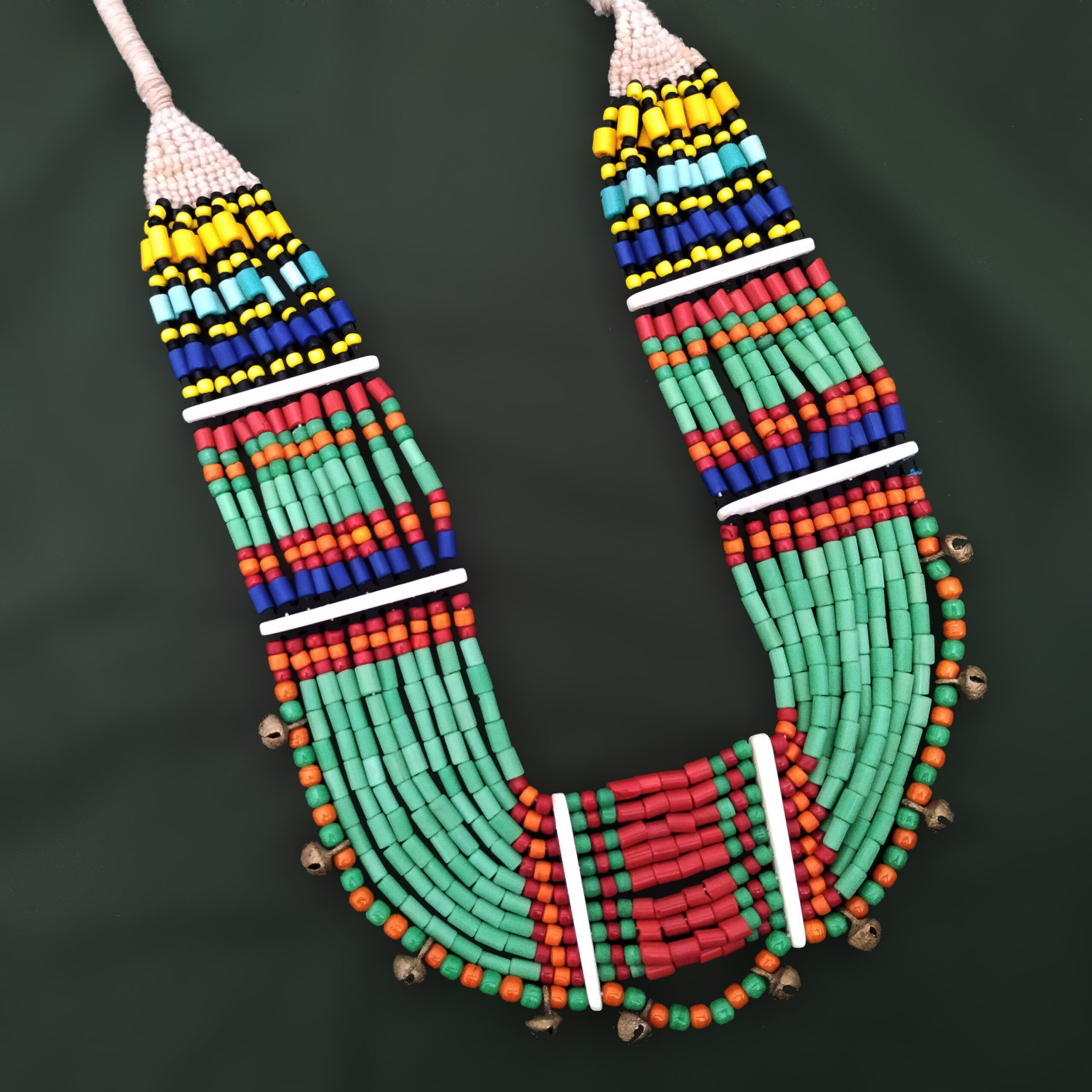I have been eyeing vintage Naga bead necklaces traded in collector’s groups for a long time. However, whenever one comes up for sale, I do not buy them. Not only were these out of my budget, but I was not sure how well the fibre in the necklace would hold up during my rough usage. I was contemplating buying new beaded necklaces inspired by Naga jewellery. I wanted to be sure that the brand/collective that makes them is artisan led, for I have heard of several tales of appropriation when it comes to modern Naga style jewellery. Recently I saw that Bamboo tree, a collective that makes and sells jewellery inspired by North East India and Tibet sold Naga style bead necklace.

Naga style bead necklace at Itokri
When shopping online, there are a select few websites which I purchase Indian handloom and handicrafts from. One such online store is Itokri which sells various fabrics, garments and jewellery. Over the years, I have bought handloom yardage for tops, a saree, and more than a dozen reusable face masks. This time, I got a green kurta and a Naga style bead necklace from Itokri. I was spoiled for choice with Bamboo tree jewels’ range but eventually I picked the green piece is the middle. For Rs.750 (INR) this piece is an absolute bargain.

The beads are glass and not plastic and it has brass ghungroos. The ends have macramé just like the vintage Naga jewellery. The necklace is heavy and feels expensive. I am sure that I will make quite a statement when I wear it to work. While this is not for a jewellery expert or a connoisseur who hunts for “authentic finds,” this necklace is quite lovely and I cherish it.
Here is a short note on the Naga jewellery that I was referring to above. I am not an expert in Naga jewellery or any type of jewellery from the North East. Hence the secondary research on the internet.
Naga bead jewellery
Naga bead jewellery is worn by Naga people of North East India and Myanmar. Beaded necklaces were a portable means of displaying and carrying wealth. The components that went into making necklaces were regarded as currency items themselves. These beads are traditionally made from seeds, bone, ivory, shells, glass, and stones. Among the Nagas, the necklaces were a symbol of status and wealth. They were accumulated as heirlooms and were passed as dowry.
Thick stole like necklaces were worn by women with men wearing sparser necklaces. Each tribe has their own style of necklace and uses different materials. Seeds such as Job’s tears, which are commonly used in traditional medicine, are used to make Naga bead necklaces. Stones such as agate, jasper, and carnelian sourced in India are used, as they are believed to have healing properties. Wooden beads are often carved into intricate designs and are sometimes painted with bright colors. Different types of shells are strung together to create stunning pieces. In the past, ivory and hornbill beaks would also be used, though they are illegal now.


Konyak Naga necklaces
The Naga style bead necklace sold online could have be inspired by those worn by the women belonging to the Konyak tribe. Jahnabee Borah, refers to this multi-stranded style as Likpha. Typically, cylindrical glass beads in red, orange, green turquoise and dark blue are used. Each colour has its own meaning in their lexicon. The glass beads used in the past were from India or trade beads from Czechoslovakia, Venice, France, and China. Since these are multi stranded necklaces, the fibre used to thread them are knotted in the end using macramé before ending in a loop or a button closure.
Another popular design is the yonghan, made with long strands of colourful beads. The yonghan is often worn by men and is believed to symbolize strength and bravery. The taksen is made with strands of black and white beads and is believed to ward off evil spirits and is often worn by women during important ceremonies and festivals.
Further reading to learn more about Naga style jewellery
- Gabriela Barnat. 2022. “Jewelry: A Symbol of Identity and Status of Konyak.” Gabriela Barnat. Gabriela Barnat. July 7, 2022. https://www.gabrielabarnat.com/stories/jewelry-a-symbol-of-identity-and-status-of-konyak.Kanungo, Alok Kumar. 2007. “Naga Ornaments and the Indian Ocean.” Bulletin of the Indo-Pacific Prehistory Association 26: 154–62. https://doi.org/10.7152/bippa.v26i0.12005.
- Julian, Jacobs. 1990. The Nagas: Hill Peoples of Northeast India, Thames & Hudson.
- Ranade, Rageshree. n.d. “The Social Bound of Ornaments of Naga Tribes beyond Life.” MASH India. Accessed March 18, 2023. https://www.mashindia.com/the-social-bounds-of-ornaments-of-naga-tribes-beyond-life/.
I hope you find it interesting
Cheers



What do you think?